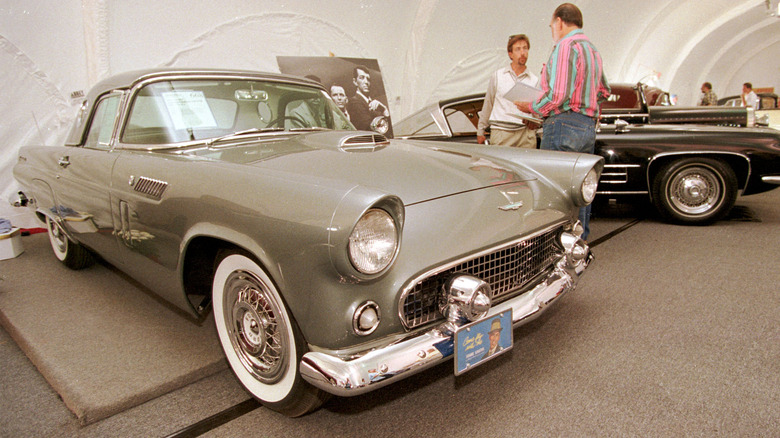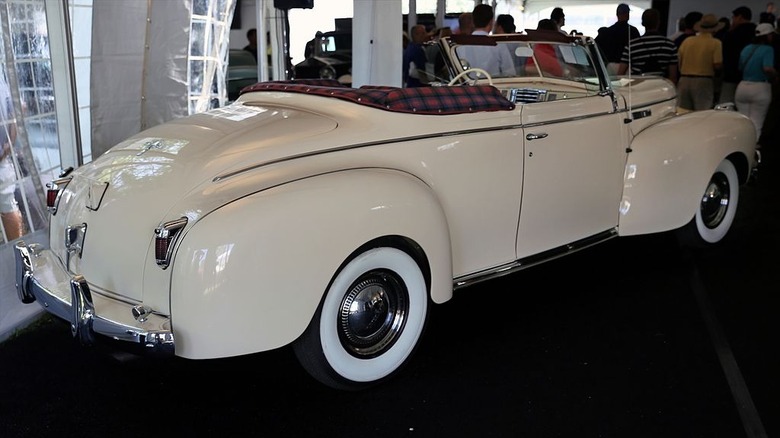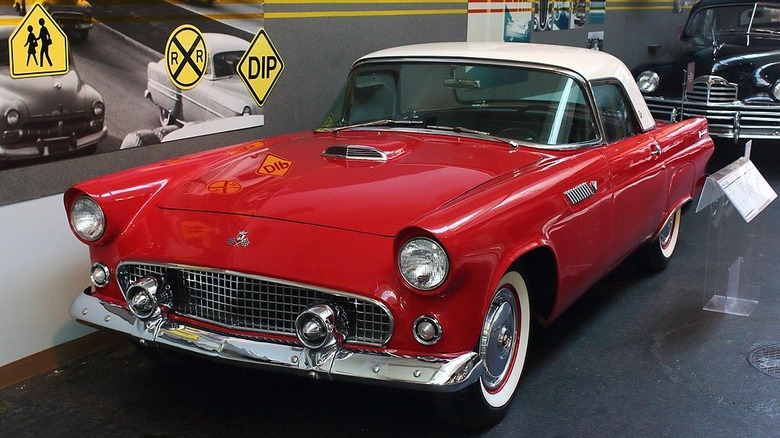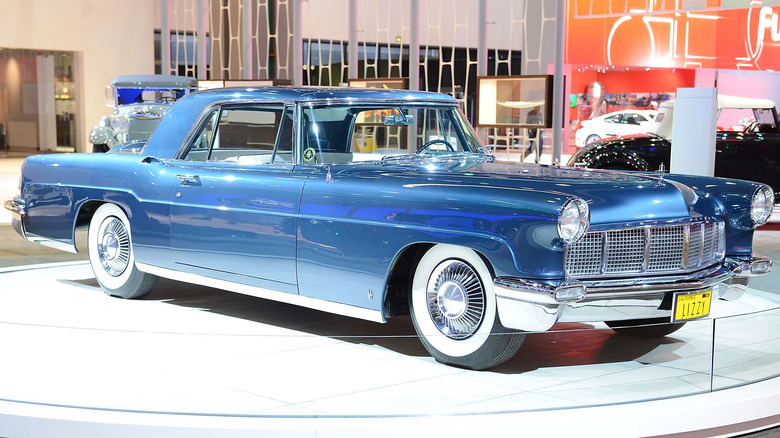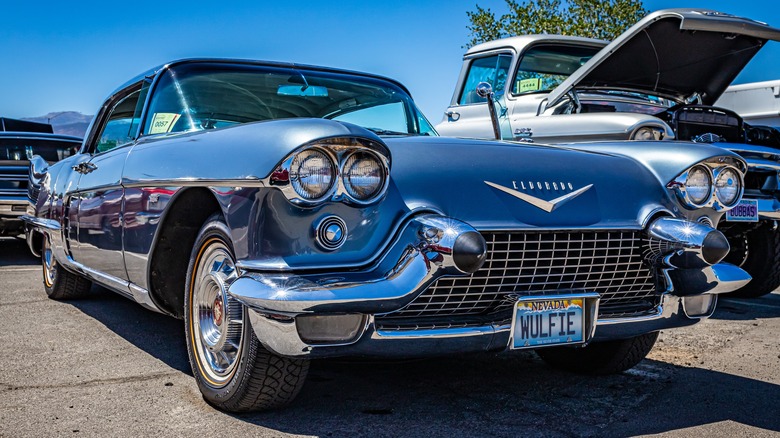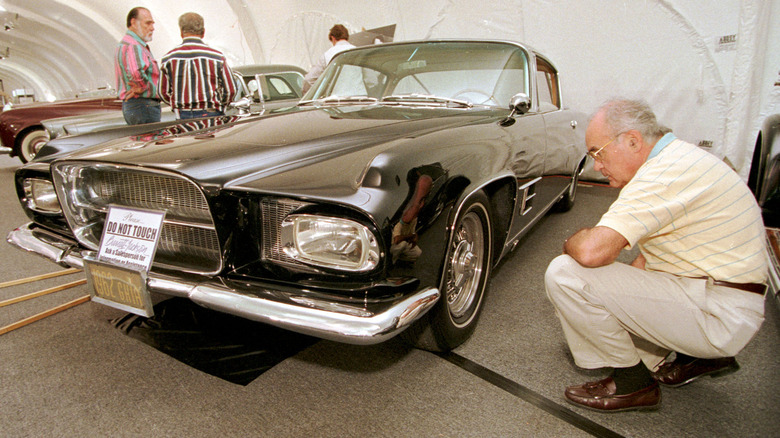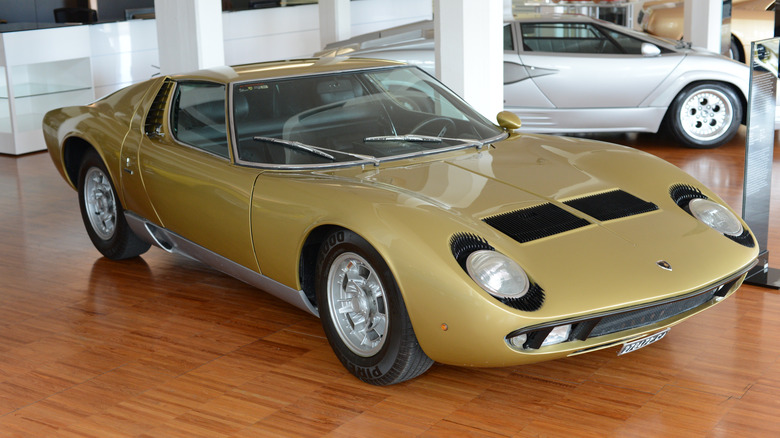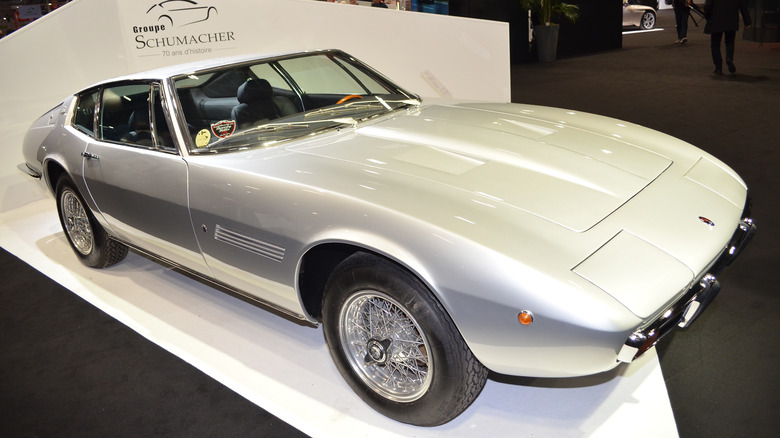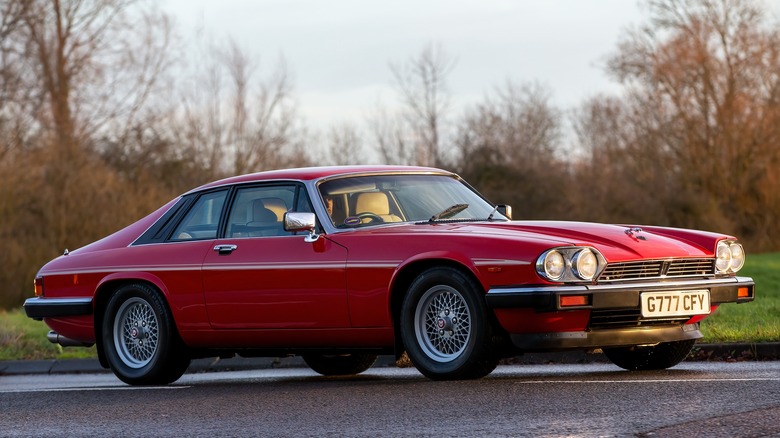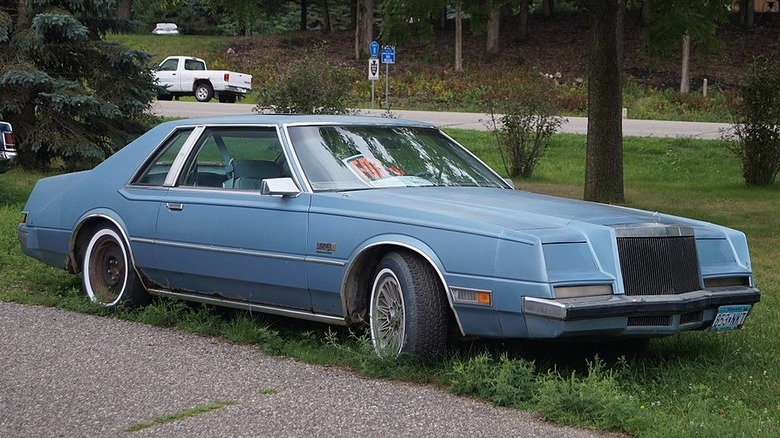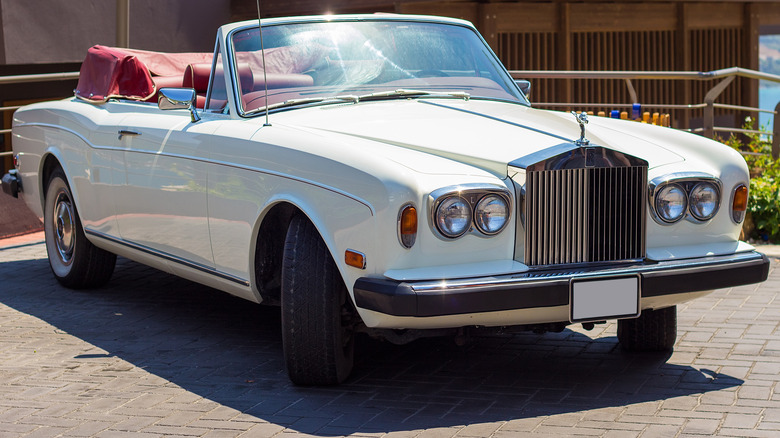10 Cars In Frank Sinatra's Collection That Prove He Had Great Taste
Few artists have left as great an impression on 20th-century popular music as Frank Sinatra. From his humble beginnings in Hoboken, New Jersey, to the bright lights of Manhattan and the Las Vegas Strip, Sinatra became a dominant musical force thanks to his distinctive voice and big band-style jazz-inflected songs that could be loosely categorized as swing.
As a member of the notorious "Rat Pack" alongside fellow hellraisers Dean Martin, Sammy Davis Jr., Joey Bishop, and Peter Lawford, Sinatra became synonymous with 1950s excess and a poster boy for the post-war American Dream. Musically, however, he was always focused and disciplined and a natural talent on stage and in the studio. In later years, he worked with such lauded arrangers and composers as Quincy Jones and Antonio Carlos Jobim, making him all the more accessible to the public's ear with a rich and diverse catalog and an unquestionably unique style.
Sinatra was also known for being effortlessly cool. His laid-back attitude on and off stage, his impeccable clothing, and his confident swagger sucked the air out of any room he entered. What is not so widely known is that behind the style and the music, Frank was something of a petrolhead, having owned several of the most exclusive vehicles from European and American manufacturers. Here we will look at 10 cars that prove "Old Blue Eyes" had an immaculate sense of taste that extended beyond his trilby hat and tailored suits and onto his garage forecourt.
1942 Chrysler Convertible
In Frank's early days, he must have yearned for the opportunity to drive in style with the wind in his hair, and even though it was basic compared to the exclusive vehicles that would come later, his purchase of a 1930s Chrysler convertible allowed him to dream big. Eventually, Sinatra started making waves in the recording industry after cutting his first record in 1939. Staying true to the brand, the upgrade of his daily driver to a 1942 Chrysler convertible was a precursor of the successes and excesses to come and seemed to announce the arrival of this soon-to-be megastar (via Vintage Car Collector).
Nowadays, these early 1940s Chryslers are highly sought-after since Chrysler ceased production around this time due to the war effort, making them very scarce. One recently-sold example was a '42 New Yorker, with an 8-cylinder "straight eight" engine and three-speed overdrive transmission in gold with a burgundy top and interior. This model even had an electrically-operated hood, something that would have been a great novelty in its day.
Sadly, very few of these cars survive today, with most undergoing extensive restoration to return them to their previous glory. After World War II, Chrysler remodeled the 1942 cars in keeping with the times. By the 1950s, they favored more practical designs, doing away with the fins and chrome in favor of flush styling and much less chrome, making these early icons all the more collectible today.
[Featured image by Mr.choppers via Wikimedia Commons | Cropped and scaled | CC BY-SA 3.0]
1955 Ford Thunderbird
The Thunderbird was one of Ford's most desirable early coupes, befitting Frank's status as a star of both stage and silver screen, having been awarded an Oscar for 1953's "From Here to Eternity" (via IMDb). Continuing his preference for convertibles, this was a beloved car of Sinatra's, as evidenced by the many photos of him posing with it and smiling from ear to ear (via Vintage Car Collector).
Aesthetically speaking, the Ford Thunderbird was an absolute stunner from nose to tail, with its color-coded hooded headlamps, large chrome grille, hubcaps, and foglamps, long hood with air intake, and understated tail fins. Originally offered at just under $3,000, it was considered lightweight at 2,981 lbs, had a three-speed transmission, and reached a dizzying top speed of 112 miles per hour. The Thunderbird represented a return to the limelight for Sinatra after a faltering career at the start of the decade, and what better way to say "I'm back" than cruising in this luxury V8 slice of Americana?
As a rare domestic two-seater, the Ford Thunderbird signified a new era for the American automobile industry as the nation experienced a time of economic growth. Along with Chevrolet's Corvette, these aspirational cars perfectly represented the age of excess that was to follow, and of course, Frank Sinatra was right there in the driving seat.
[Featured image by Andromeda2064 via Wikimedia Commons | Cropped and scaled | CC BY-SA 4.0]
1956 Continental Mark II
As the most expensive production car in over 20 years, the Continental Mark II was considered the height of luxury in the mid-'50s, and Frank Sinatra would have been keen to purchase this stunning hard-top coupe. By now, his career was in full flight, with the release of his concept albums "In the Wee Small Hours" and the legendary "Songs for Swingin' Lovers!" This was the era of excess, with Frank becoming the official leader of the Rat Pack as the most celebrated member of the very exclusive Los Angeles social group that previously included Humphrey Bogart and Errol Flynn.
The Continental Mark II was originally made by Ford and was introduced a year and a half after the flagship Thunderbird. Continental phased into Lincoln some years later when the brand adopted the old star-shaped logo as its figurehead. It was considered to be a Rolls-Royce for the U.S. market and was very well-appointed to match the competition.
Notable for its upright spare wheel cover above its rear fender, the Mark II was mostly hand built, with hand-stitched interiors of imported Scottish leather, and subject to rigorous quality-control inspections. The result was a worthy successor to the Thunderbird, with a 368 cubic-inch V8 engine producing 285 horsepower. With its many modern (at the time) functions, including power brakes, power steering, power locking, power seats, and power windows, it was indeed a marvel for the electronic age and well-suited to global megastars such as Frank Sinatra.
1958 Cadillac Eldorado Brougham
Cadillac was keen to compete with Ford in the luxury coupe market, and in 1958 the company introduced the Eldorado Brougham. It was considered a step up from the already extravagant Continental Mark II but a different beast altogether. If the Continental is understated class, this Cadillac is absolute flamboyance and a car worthy of cruising the Las Vegas strip, where Sinatra was a regular fixture at venues including the Desert Inn.
Frank's 1958 Cadillac Eldorado Brougham was an absolute beauty in burgundy with a cream and gray leather interior that was put up for auction in 2009. Its glove box vanity set included six shot-sized tumblers and a silver cigarette case, items which would almost certainly be frowned upon today but were actively encouraged in its day.
Specifications included a 365 cubic-inch V8 engine that produced 335 horsepower, power brakes, a four-speed automatic transmission, self-leveling suspension, and electric windows (via The JBS Collection). But this car was much more than the sum of its parts; it represented the golden age of American automobile manufacture. If one model in Frank's history of purchases is the ideal symbol of the excesses of the Rat Pack's heyday, it is this car. Fast, fun, and flamboyant, with plenty of flair to spare.
1962 Dual Ghia L6.4
Fast forward to 1962, and we start to see a change in car designs, from the extravagant geometrically-shaped land yachts of the late 1950s to curvier profiles with shorter wheelbases. This is certainly true of the beautiful Dual Ghia L6.4, which was more modest looking than the previous three of Sinatra's picks, but no less exclusive, with very few being made available to the public in 1962 (via Vintage Car Collector). Of course, Frank had to snap one up while another went to his fellow Rat Pack partner Dean Martin.
Like all of Frank's previous cars in this list, the Ghia featured a V8 engine, this time with a 383 cubic-inch block producing 335 horsepower. It had a three-speed automatic transmission and was similar to the Cadillac Eldorado Brougham with its two-plus-two coupe seating configuration. It must have felt space age to have sat in a car of this caliber in 1962, as unlike its contemporary British marques, Rolls-Royce and Jaguar, that upholstered their interiors in walnut and wool, this was of the finest Italian leather, with large convex analog instrument dials and lavish chrome.
Despite being considered one of the world's finest automobiles at the time of its creation, the Dual Ghia L6.4 simply couldn't turn a profit due to the difficulties of manufacturing a car in Italy exclusively for the American market. Only 26 vehicles ended up being created, and they remain sought-after, with some being sold at auction for almost $300,000.
1969 Lamborghini Miura P400S
Often dubbed the world's first supercar, Sinatra was enthusiastic about buying this Italian classic, saying it was more aspirational than a Ferrari. Despite this, he likely gave away his Lamborghini Miura P400S soon after he bought it. Still, as one of the world's most iconic Lamborghinis, it is easy to see what first drew the car connoisseur to travel to Italy to buy one in person.
At the time of its release, the Lamborghini Miura was the fastest production car in the world, per Lamborghini, with a top speed of 174 miles per hour. Its 3,929cc V12 engine produced 350 horsepower, and it had a manual five-speed transmission. Frank's was the coveted "S" version, with luxuries like air conditioning, an overhead console, and an upgraded engine with an extra 20 horsepower thrown in. His was custom created in his favorite color, orange, and had factory-fitted boar skin leather trim.
With some models selling at over a million dollars at auction, this is undoubtedly one of the most valuable cars that ever graced Frank Sinatra's stable (Rod Stewart and Miles Davis are also famous owners of this prized machine), and there are only around 100 400S models still in existence, adding scarcity to its value. We'll never know precisely why Frank didn't hang on to this charging bull for longer, but he remained a fan of Italian sports cars, as evidenced by his next purchase.
1970 Maserati Ghibli
While not as collectible or recognizable as the Miura, but still effortlessly cool in its own right, Frank Sinatra's next car purchase was a Maserati Ghibli, which was sold to him by his son-in-law in 1973. The Ghibli is more understated than the Lamborghini and is perhaps more stylistically in keeping with other sportscars he previously owned, such as the Ford Thunderbird and the Dual Ghia L6.4.
It's no surprise that the Ghibli (meaning "desert storm" in Egyptian) bears such a resemblance to the Dual Ghia, as it was created by some of the very same designers at the Ghia factory in Turin, Italy, and it also featured the same two-plus-two seating configuration and long wheelbase as its 1962 cousin. Sinatra's understated but ultra-stylish model was silver with black leather trim and chrome accessories, and notable features included popup headlamps and front and rear servo-assisted disc brakes.
With its V8 engine with a 288 cubic-inch capacity that produced over 300 horsepower, the Ghibli didn't hang around, with a top speed of 154 miles per hour. Its performance and notoriety attracted famous customers, including Peter Sellers and Frank's friend and Rat Pack companion, Sammy Davis, Jr. Sinatra's own model was eventually sold to actor George Hamilton, preserving its status as one of the most interesting cars to have come under the singer's ownership.
1976 Jaguar XJS V12
As a replacement to the stunning Jaguar E-Type, the XJS V12 was one of the British brand's most recognizable sports cars from 1976 to the mid-1990s, and it's easy to see why, with its distinctive long hood, broad double headlamp clusters, and tapering rear buttresses. Performance-wise, it was a powerhouse, with a 12-cylinder engine that propelled it to almost 150 miles per hour, with a 0-60 time of 7.8 seconds.
This particular XJS was especially well appointed, in true Sinatra fashion. It included a primitive car phone by General Electric and a high-end Panasonic stereo system in an overhead console, both features that would have been considered the height of in-car sophistication at the time.
It's possible that Old Blue Eyes wouldn't have elected to buy this European classic, as it was a wedding gift from his wife, Barbara Marx, and it marked a departure from the U.S. and Italian marques that he previously favored. Frank reciprocated by buying his wife a Rolls-Royce Silver Shadow in blue, both of which were auctioned together in 2015. Knowing Sinatra's love of luxury saloons as we do, this is no surprise, as the Rolls was almost certainly a car that Frank would have considered buying for himself. However, the XJS stayed with him for 19 years, lasting almost as long as his fourth and final marriage to Marx, which ended with Frank's death in 1998.
1981 Chrysler Imperial FS Edition
By the 1980s, Frank Sinatra's lifelong dedication to the Auburn Hills, Michigan, brand paid off when he received his very own initialed Chrysler Imperial "FS Edition" in 1981. This was a limited run of the luxury saloon that was blue to suit his eye color. It even sold with a selection of Frank's "favorite cassettes," so you could swing with Sinatra as you cruised in comfort.
Historically, the Imperial moniker was applied to a range of Chrysler's luxury saloons dating back to the 1920s, so Frank would have been delighted to have been when his friends at Chrysler included his own vehicle in this prestigious run, and the "FS Edition" had a trusty V8 engine, like so many of his cars before it as well as a deluxe leather interior, a space-age electronic instrument panel, wooden trim, and a large electric sliding sunroof. It also had a rather sketchy fuel injector that caused some issues down the line, but this is best forgotten.
Frank not only gave his name to the Chrysler Imperial "FS Edition," but he owned and drove his own and helped out with its marketing. Sadly, it wasn't to take flight, and with limited numbers sold, the car was discontinued in 1983. While the Chrysler Imperial "FS Edition" failed to set the world alight like its namesake, it was once a worthy tribute to the brand's most famous customer.
[Featured image by Greg Gjerdingen via Wikimedia Commons | Cropped and scaled | CC BY 2.0]
1984 Rolls-Royce Corniche
With all the famous luxury marques on Frank Sinatra's roster of past vehicles, one of the most exclusive brands is notably absent from the list — Rolls-Royce. Having gifted one to his wife Barbara back in 1976, this Rolls-Royce Corniche was a gift from Sammy Davis, Jr. and Dean Martin, given to Frank for his 70th birthday. After having a back-to-back run of hard-tops in his possession, Frank was once again feeling the wind in his hair with this stylish British convertible.
And stylish it was, with its mason-black bodywork and burgundy leather trim. It included picnic tables to its rear and a matching set of "cocktail requisites" (meaning crystal glasses and decanters), even though it was only a two-seater. Under the hood, it was equally impressive, with a fuel-injected OHV V8 engine that was powerful enough to push the three-ton car to 120 miles per hour (per Hagerty).
Despite it being a heartfelt gift, the Corniche was re-gifted by Frank to his lifelong assistant, Ingemar Frederiksson, as a thank-you for his years of loyal service. By 1985, Sinatra came full circle, returning to his earliest Chrysler roots with a purchase of a Chrysler LeBaron Town & Country. It doesn't get much more modest than this station wagon, which, compared to his previous cars, is perhaps more befitting a man in his twilight years. This car may be the perfect allegory for a man who has nothing left to prove, who has achieved all that is possible for a mere mortal, and one who indisputably, to quote his most memorable song, "did it my way."
